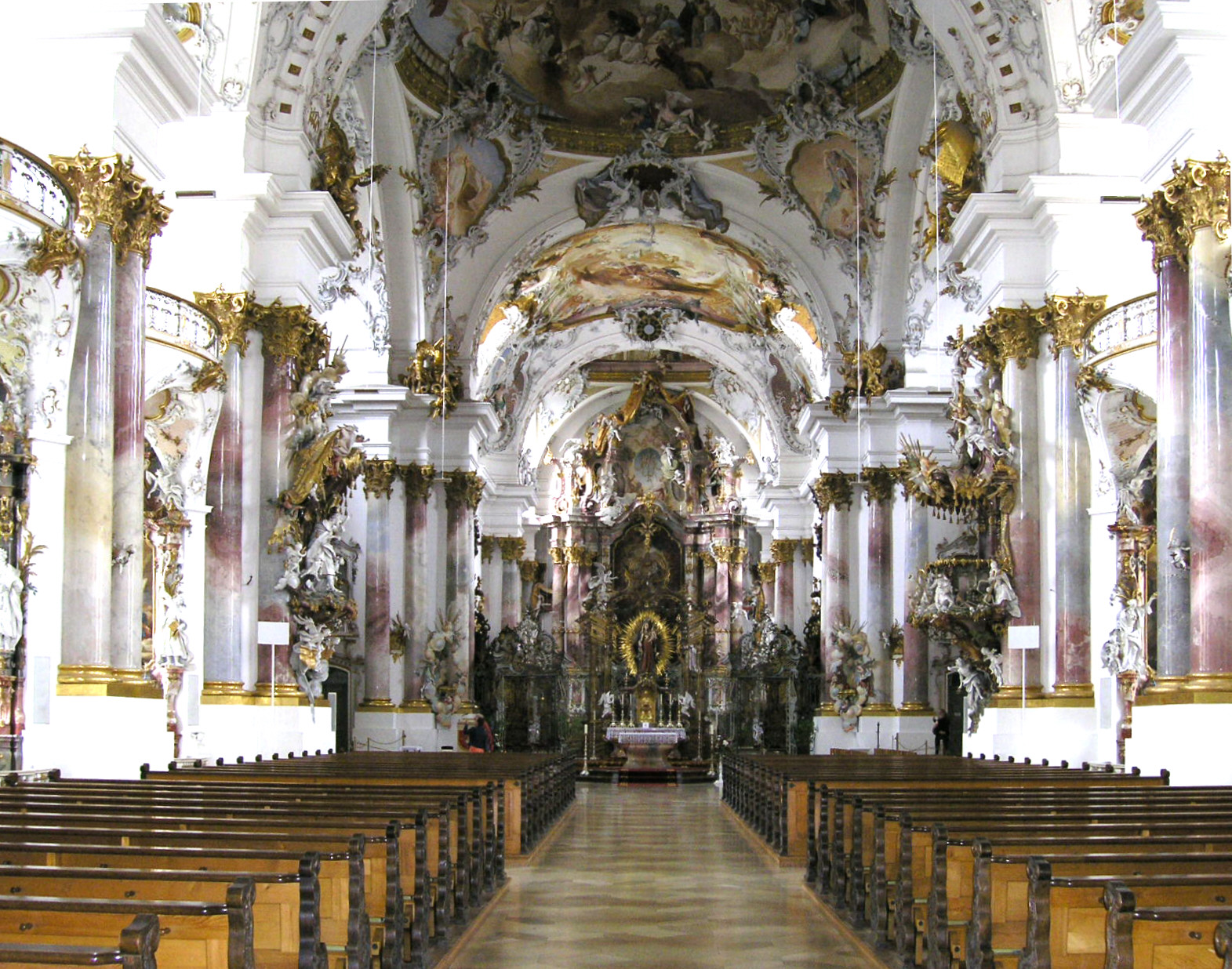Johann Michael Feuchtmayer
- Johann Michael Feuchtmayer
Johann Michael Feuchtmayer (the Younger) (sometimes spelled Johann Michael Feuchtmayr) (1709–1772) was a German Baroque stucco sculptor and plasterer of the Wessobrunner School, who worked alongside Johann Michael Fischer, Johann Joseph Christian, and Franz Joseph Spiegler to create some of the most famous churches along the Upper Swabian Baroque Route.
J. M. Feuchtmayer is considered to be one the finest artists of his time. ["Germany: A Phaidon Cultural Guide". Oxford: Phaidon, 1985. p. 33. ISBN 0-7148-2354-6.] His work on the Ottobeuren Abbey, one of the most magnificent churches of the Baroque era, was especially important. The stucco that dominates the design is his. ["Germany: A Phaidon Cultural Guide," p. 584.]
A member of the famous Feuchtmayer family, he was the son of Michael Feuchtmayer (b. 1667); the nephew of Franz Joseph Feuchtmayer (1660–1718) and Johann Michael Feuchtmayer (the Elder) (1666–1713); the brother of Franz Xaver Feuchtmayer (the Elder) (1705–1764); the cousin of Joseph Anton Feuchtmayer (1696–1770); and the uncle of Franz Xaver Feuchtmayer (the Younger) (b. 1735).
Major Works
[

thumb|right|200px|Zwiefalten Abbey stucco design by J. M. Feuchtmayer] Austria
*Wilhering—Stiftskirche Mariä Himmelfahrt (stucco in transepts and choir)
Baden-Württemberg
*Bad Säckingen—Convent Church of St. Fridolin (1751) (stucco)
*Haigerloch—Pilgrimage Church of St. Anne (1753–1755) (stucco work and side altar design)
*Kisslegg—Neues Schloss (New Castle) (1721–1727) (stucco figures of the Sibyls on the staircase)
*Seeon im Chiemgau—Chapel of St. Nicholas at the Benedictine Monastery of St. Lambert (stucco)
*Sigmaringen—Catholic Parish Church of St. John the Evangelist (altars)
*Zwiefalten—Zwiefalten Abbey (1741–1747) (stucco)
Bavaria
*Amorbach—Benedictine Abbey Church of St. Maria (high altar and other altars)
*Augsburg—Dominican Church of St. Magdalena (1716) (stucco)
*Dießen am Ammersee—Church of St. Maria (completed 1739) (stucco)
*Ottobeuren—Benedictine Monastery Church of the Holy Trinity (1737–1766) (stucco)
*Staffelstein—Pilgrimage Church of Vierzehnheiligen (stucco on the Gnadenaltar)
*Würzburg—Pilgrimage Church of St. Maria (Marienkapelle) (1747–1750) (stucco)
References
Wikimedia Foundation.
2010.
Look at other dictionaries:
Johann Michael Feuchtmayer — Wallfahrtskirche Baitenhausen, Meersburg: Immaculata, um 1710–1715, Johann Michael Feichtmayr zugeschrieben; Detail: Adam und Eva (in der Figur des Adam am linken Bildrand wird ein Selbstporträt des Malers vermutet) Johann Michael Feuchtmayer… … Deutsch Wikipedia
Johann Michael Feuchtmayer the Elder — Johann Michael Feuchtmayer (the Elder) (* 17 April 1666 in Wessobrunn (baptism); † 15 October 1713 in Konstanz) was a German painter and copper engraver from the famous Feuchtmayer family of Baroque artists associated with the Wessobrunner School … Wikipedia
Johann Michael Feuchtmayer (der Jüngere) — Stuckarbeiten von J.M. Feuchtmayer d.J. in der Basilika Ottobeuren Zwiefalten … Deutsch Wikipedia
Johann Michael Feuchtmayer der Jüngere — Stuckarbeiten von J.M. Feuchtmayer d.J. in der Basilika Ottobeuren … Deutsch Wikipedia
Michael Feuchtmayer — (born 1667) was a member of the Feuchtmayer family of Baroque artists of the German Wessobrunner School. He was the brother of Franz Joseph Feuchtmayer (1660–1718) and Johann Michael Feuchtmayer (the Elder) (1666–1713); the father of Franz Xaver… … Wikipedia
Johann Michael Fischer — (born 18 February 1692, Burglengenfeld, Upper Palatinate; died 6 May 1766 in Munich) was a German architect in the late Baroque period. [He should not be confused with the sculptor of the same name from Dillingen an der Donau, who lived from 1717 … Wikipedia
Johann Michael Fischer (Baumeister) — Burglengenfeld: Denkmal für Johann Michael Fischer in seiner Geburtsstadt Burglengenfeld in der Oberpfalz. Johann Michael Fischer (* 18. Februar 1692 in Burglengenfeld/Oberpfalz; † 6. Mai 1766 in München) war ein bedeuten … Deutsch Wikipedia
Johann Georg Üblhör — Johann Georg Üblhör, auch Ueblher, Üblher, Übelherr, Ybelher u. a. (* 21. April 1700 in Wessobrunn; † 27. April 1763 in Maria Steinbach) war ein deutscher Stuckateur und Bildhauer. Inneres der Stiftskirche von Stift W … Deutsch Wikipedia
Johann Josef Christian — Johann Joseph Christian (* 12. Februar 1706 in Riedlingen; † 22. Juni 1777 in Riedlingen) war ein deutscher Bildhauer, Holzschnitzer und Stuckateur des Rokoko. Als seine Hauptwerke gelten die Chorgestühle der Klosterkirchen Zwiefalten und… … Deutsch Wikipedia
Johann Joseph Christian — (born 12 February 1706 in Riedlingen; died 22 June 1777 in Riedlingen) was a German Baroque sculptor and woodcarver. His masterworks are considered to be the choir stalls in Zwiefalten Abbey and Ottobeuren Abbey.Christian s rare double gift as a… … Wikipedia

